Introduction: The Fascinating World of Hawks and the Importance of Identification
They are large majestic birds of prey that glide through our skies, making shadows on the pavement. Sometimes it can be difficult to identify them dancing in the sky. Eagles, hawks, vultures, and other large birds can look the same when they are a mere speck in the sky. However, it is important to know who you’re talking about and looking at so you can learn more about the feathered friend traveling your local sky. It can be fun and rewarding for the whole family to learn about the big native birds in your area. It can help children gather an understanding and respect for other beings and, more specifically, hawks.
Without knowledge of the small differences in some of these birds, it would be impossible for conservation efforts to make sense adequately. Many have similar coloring and physical characteristics, which make identifying them difficult. In this article, we will discuss some of the most efficient ways to identify them flying above you.
Size and Shape: Understanding the Role of Size and Shape in Identification

Wing size and shape comparison of eagles, hawks, falcons, and owls.
©Internet Archive Book Images / CC0 1.0, Flickr – License
It can be tricky when looking at wing size and shape while trying to identify if your gliding bird is a hawk or eagle. The length of an eagle’s wing is much longer than that of a hawk or falcon. There are four bird types to further break down the structure and wing size of raptors, or as they are more commonly known, birds of prey.
Eagle

©plains-wanderer/Shutterstock.com
The eagle has the most length in their wingspan than any other bird of prey.
Eagles are much larger than hawks, and even at great heights, they look enormous. Bald eagles are excellent at fishing and tend to stick close to a source of water. They do soar similar to buteo hawks but do not hunt mammals on open fields much. Instead, they steal land prey from other raptors and stick to hunting and divebombing fish. They are also seen eating dead animals near the roadside, like another raptor, the vulture. Golden eagles are the only other eagle native to the United States. They do hunt mammals and could be mistaken for one by untrained eyes. The bald eagle is easy to identify since it is the only raptor with an all-white head. The golden eagle is also known to obtain great speed when diving from above, much like a peregrine falcon.
Types of eagles:
- Bald eagle
- Golden eagle
Buteo
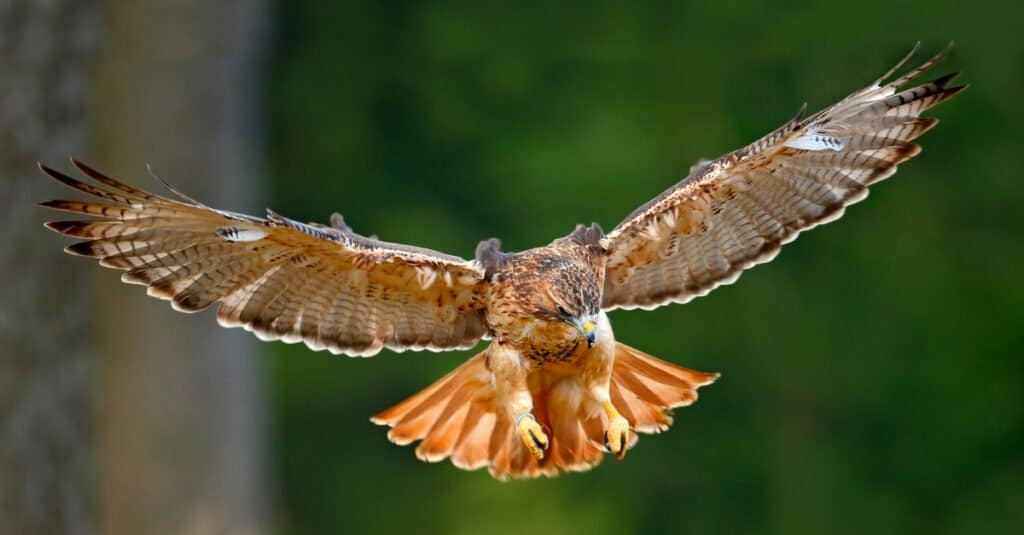
The red-tailed hawk’s distinct tail feathers help make its identification easier than the others.
©Ondrej Prosicky/Shutterstock.com
The Buteo are also known as soaring hawks, which are large hawks, like the red-tailed hawk that you see gliding very high in the shy. They have long, stout wings and shorter tail feathers than that of the eagle and the other smaller ones, known as accipiters. Buteos fly very high and make soaring endlessly look easy. If they aren’t soaring from impressive heights, they can generally be seen sitting roadside on fences, telephone poles, or in tall trees. They prefer height when roosting or watching for prey. They are not commonly seen in forests or woodlands and tend to stick to more open-range hunting. These are the most commonly seen hawks and what you are likely more familiar with classifying as one. Sometimes buteos are seen soaring together during their yearly migration.
Some examples of buteos are:
- Red-tailed hawk
- Common black hawk
- Ferruginous Hawk
- Broad-winged hawk
- Rough-legged hawk
- Swainson’s hawk
Accipiter
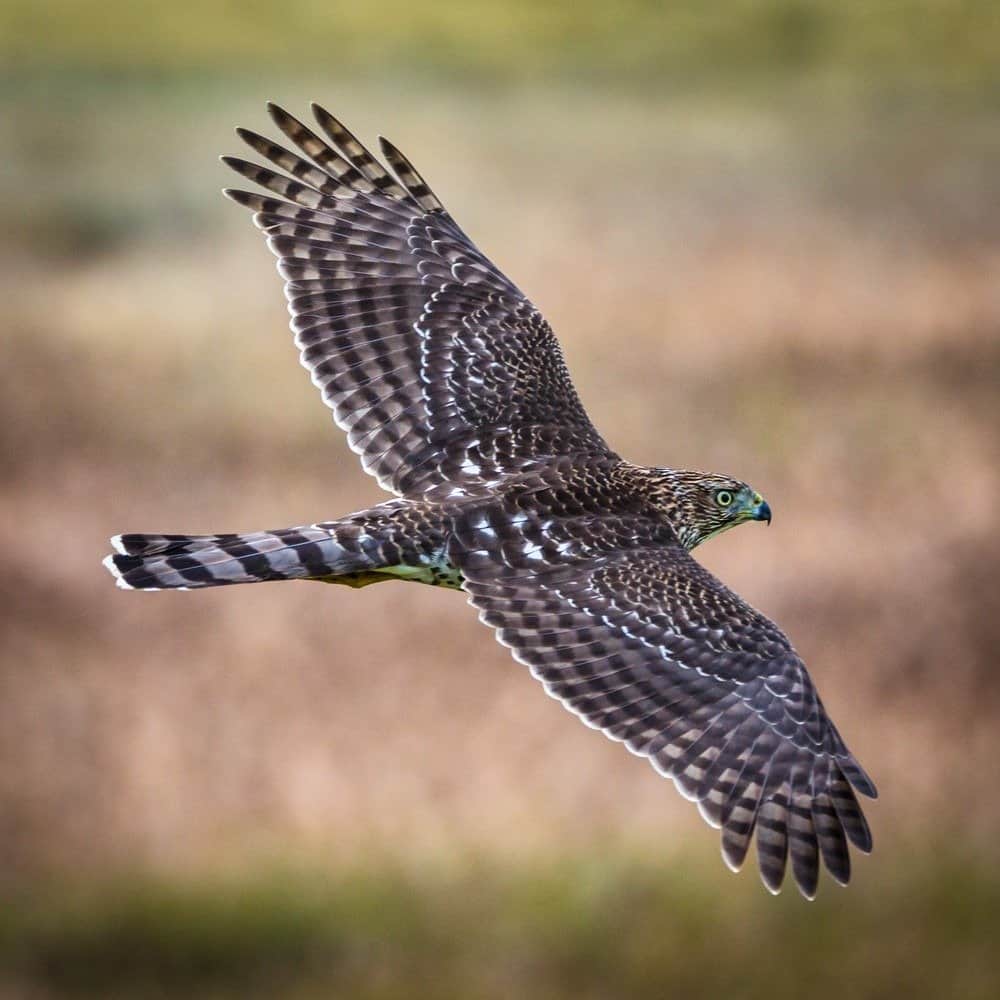
A
Cooper’s hawk
glides a small distance while searching the ground below for small prey.
©michaelschober/Shutterstock.com
Most accipiters are smaller and more delicate than buteos. Their wings are considerably shorter, and their tails are longer than the buteos’. These are hawks that you generally won’t see soaring in the open sky over fields. Accipiters are smaller woodland versions that hunt from the safety of trees, rocks, or brush. Being able to tell the difference between each of the accipiter hawks is difficult, even for the trained eye. The birds all have extremely similar ways of flying, and the physical attributes of their wings are also identical. They reach maturity at two years old, and that is when it becomes tough to distinguish their flight patterns. Before they reach maturity, many types of accipiters look similar during their juvenile molting stage. Spots and coloring change with every molt, and a juvenile from one family can look like an adult from a different family. It’s important to look at all of the physical attributes of the bird in question and not just its coloring.
Accipiters prefer to engage in the stalk, dash, and catch strategy when hunting. If you do catch them during a high-altitude flight, you will notice that they have a specific flight pattern when compared to the eagle, buteo, and falcon. The accipiters will flap their wings twice, then glide for a short bit. This repeats itself as many times as needed to get the hawk to its destination.
Some examples of accipiters are the:
- Cooper’s hawk
- Sharp-shinned hawk
- Northern goshawk
- Swainson’s hawk
Falcon
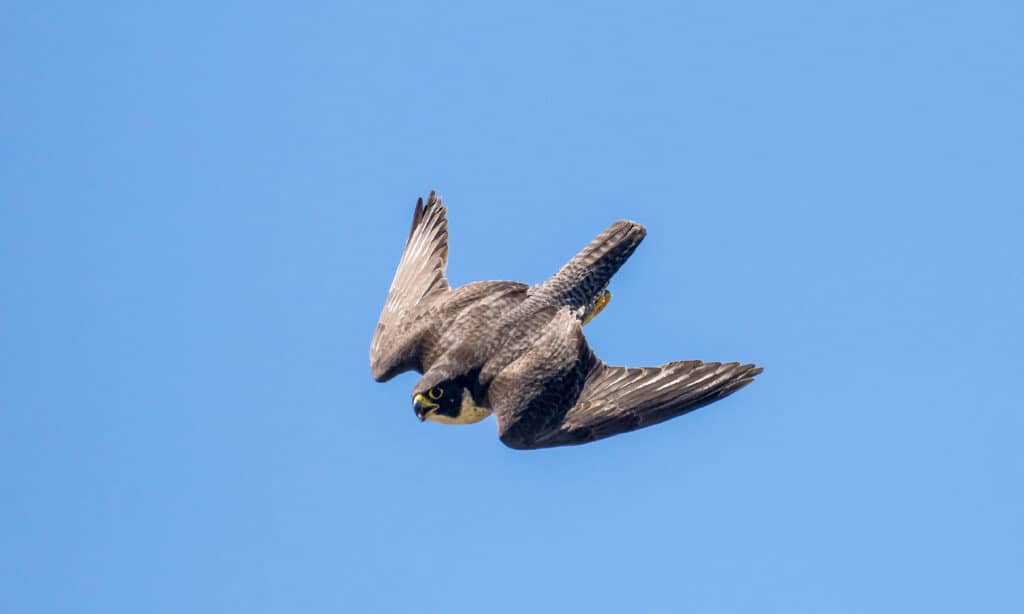
Peregrine falcons attack birds in the air and have a very specific, soundless wing form when diving to snatch up their prey.
©iStock.com/Ken Griffiths
Falcons are considerably smaller than all the other raptors. What they lack in size, they make up for in speed and cunning. Their wings are smaller and shorter than the hawk or eagle and have a long, angular, and slender appearance compared to the wings of the other raptors. They can be fun to watch as they dive and quickly cut through the air. They are also good at harassing other birds in flight, and sometimes they choose one for dinner. Falcons, such as the peregrine falcon, can reach over 200 mph when they dive after prey. Most eagles, buteos, and accipiters are quick but do not even come close to reaching the speeds of a falcon. Think of all other raptors as airplanes and helicopters; now, think of falcons as small, efficient jets.
Falcons come in varying sizes, with the gyrfalcon being almost as large as the red-tailed hawk. The American kestrel is songbird-sized, with the merlin being slightly larger with a stockier, more robust build. Both peregrine and prairie falcons are roughly the size of a crow and are considered mid-sized falcons.
Examples of falcons native to North America:
- American Kestrel
- Merlin
- Prairie Falcon
- Peregrine Falcon
- Gyrfalcon
Plumage and Coloration: Examining Feather Patterns and Color Markings as Identification Clues
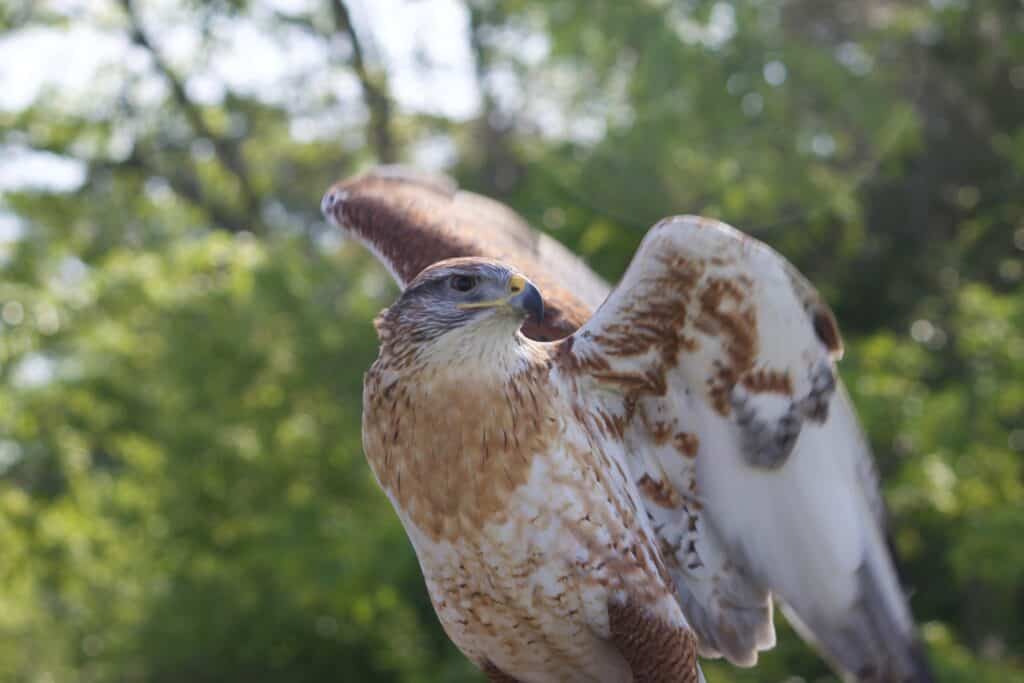
Ferruginous hawks are beautiful and unique but can still be easily confused with other larger versions.
©Chris Rosario/Shutterstock.com
Now that we are moving on to the specific features of each type for easy identification, we will only be discussing the two types of hawks; buteo and accipiter. Falcons and eagles are not hawks, and their size should be the telltale sign that you are not dealing with identifying one but a different family of birds.
Buteo
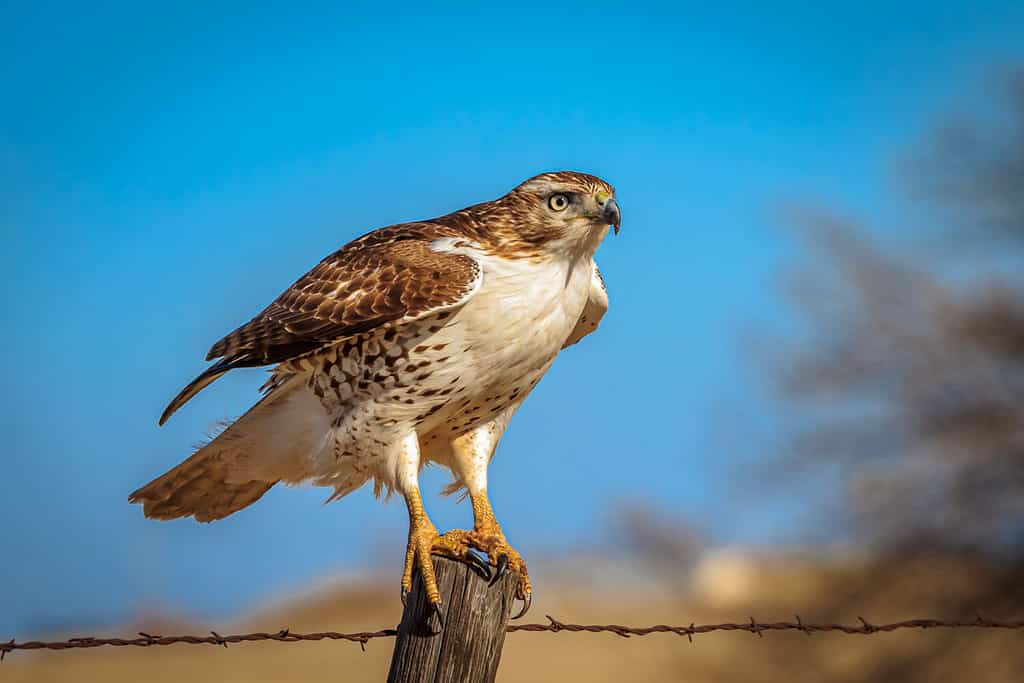
©Richard G Smith/Shutterstock.com
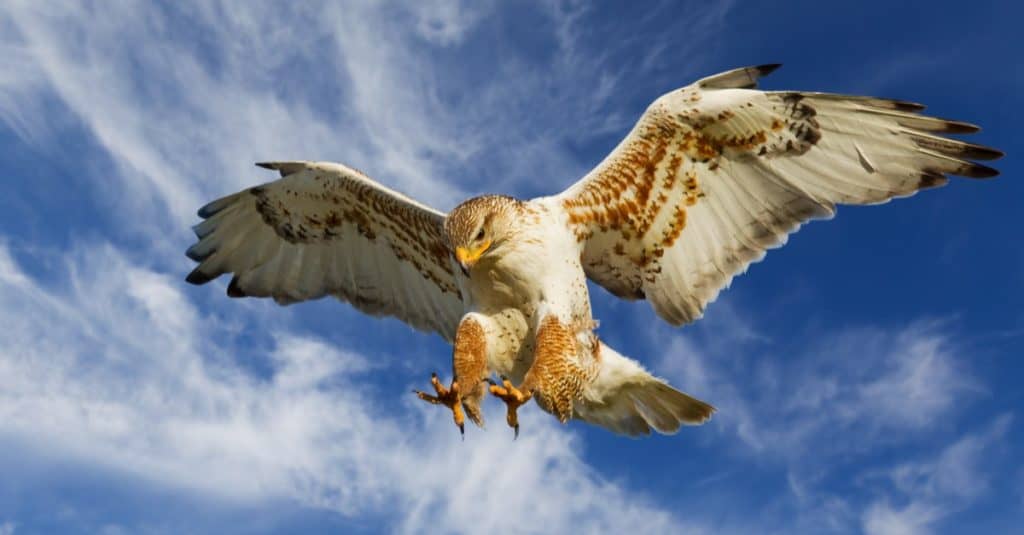
©Stephen Mcsweeny/Shutterstock.com
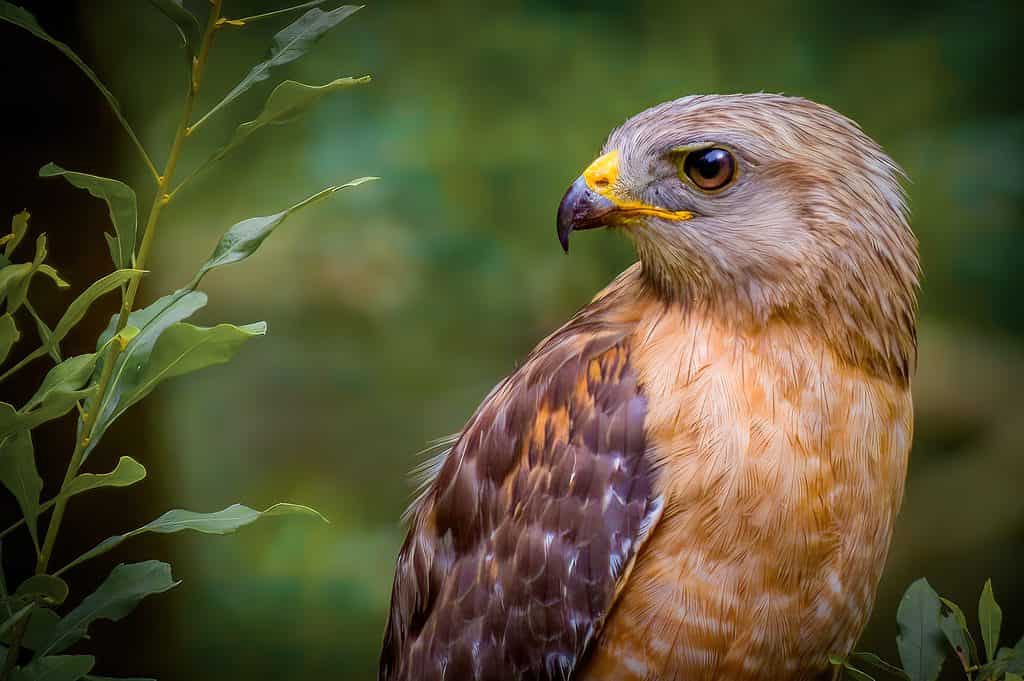
©Casey Ray Photography/Shutterstock.com
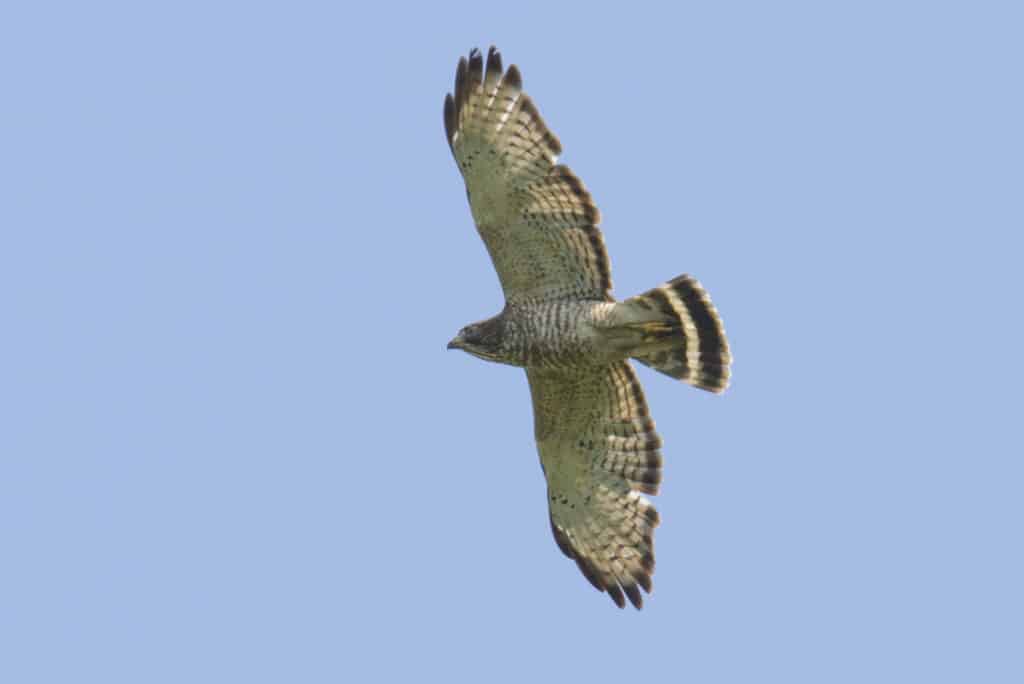
©iStock.com/lrh847
Red-tailed hawk (Buteo jamaicensis)
The red-tailed hawk isn’t too much of a mystery when identifying. If anything, since it is the easiest of the buteo bunch, use their characteristics as a gauge when identifying other less-recognizable hawks. The outstanding feature of the red-tailed hawk is its red tail. Otherwise, these could be mistaken for one of the other buteo hawk species. To make the matter even more complicated is the knowledge that five different species of red-tailed hawks exist in North America. Of course, there is also a difference between juvenile and adult red-tailed hawks to further your confusion!
Their adult coloring is dark brown on its back and head, which sharply contrasts against the light beige or white belly and underparts. About midway down the chest of the bird are brown spots or lines, as you’ve surely seen on their feathers before. This band can be several inches wide with light-colored feathers above and below the brown and white speckled line. The red-tailed hawk’s eyes are a brilliant golden or golden brown. Immature red-tailed hawks do not always have any “red” in their tailfeathers, as this can come with their final molt before becoming an adult.
Ferruginous hawk (Buteo regalis)
This hawk is similar to the rough-legged hawk and is sometimes called the Ferruginous rough-legged hawk. These mighty birds winter in Argentina annually but spend the warmer months on the west coast of North America. They prefer the vast open plains and deserts for hunting. Their wingspan is approximately 60 inches. They have a grey head, white underside, and rust-colored shoulders and legs. They also have feathers down to their talons. The dark morph is rare to see and does not have any white on it and is instead dark all over. They are one of the largest in the world.
Red-shouldered hawk (Buteo lineatus)
The red-shouldered hawks are similar to red-tailed hawks though they are smaller and slender. The red-shouldered hawk has obvious red shoulders and a bright orange underside without a speckled feather band like the red-tailed hawk. These also have a black tail with white bands that is unique to this bird. They also tend to be less afraid of humans than red-tailed hawks and may let you approach them. They also flap their wings a bit more than red-tailed hawks giving them an accipiter look.
Broad-winged hawk (Buteo platypterus)
The broad-winged hawk is the smallest in the buteo family and is half the size of the red-tailed hawk. This one tends to be more secretive and is seldom seen. They have a barred reddish and cream-colored underside with the most concentrated colored banding near the top of their chest. The tail has one or more centered white bands among the bands that run next to the white. Under the wings is creamy white. The broad-winged hawk has much shorter wings and tail feathers and tends to flap their wings more than other buteo hawks.
Accipiter
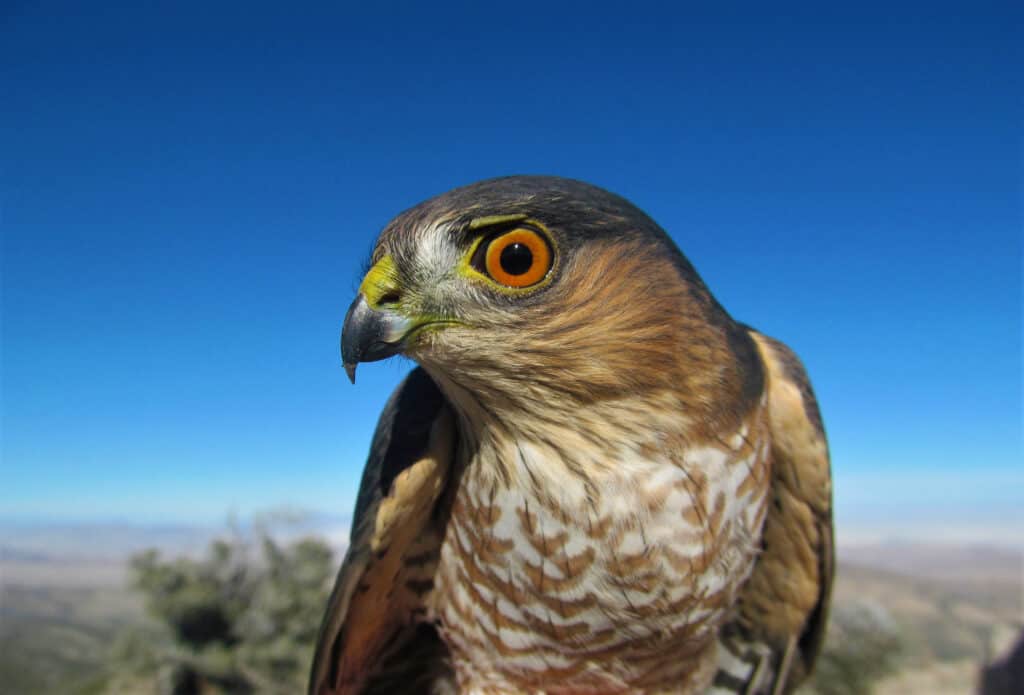
©RJ Ridley/Shutterstock.com

©J. S. Fisher/Shutterstock.com

Northern Goshawk
©iStock.com/Henk Bogaard
Sharp-shinned hawk (Accipiter striatus)
Sharp-shinned hawks are approximately the size of a blue jay and are the smallest accipiter hawk in North America. They have a greyish brown or greyish blue underside with reddish and cream-colored barring on the chest. Their crown is black, with a greater contrast on the males. They have large reddish-yellow eyes that change colors as they mature. They have a wingspan of 17 – 24 inches, with the males being on the smaller side.
Cooper’s Hawk (Accipiter cooperii)
The Cooper’s hawk is roughly the size of a crow and is a medium-sized accipiter hawk. They also have the shortest wings and longest tail of the accipiters. Compared to others, their wingtip is blunt in appearance. The coloring is very similar to the sharp-shinned hawks’. They have a dark grey or black crown, a brownish-red body, with a cream-colored underside with reddish bands. They tend to have a white eyebrow line above their eyes.
Northern Goshawk (Accipiter gentilis)
The goshawk is very large and is comparable to the red-tailed hawk. They have very long tapered wings and long, bulky tail feathers. While gliding, they flex their wingtips downward, making a downfacing “c” shape. They have a very distinctive bluish-grey back and a white band separated by black on their cheeks. These are beautiful birds that do not look like others. Their underside is white with slight black or grey banding. The goshawk’s tail is black and wedge-shaped.
Swainson’s Hawk (Buteo swainsoni)
These beautiful birds claim the western open plains and deserts as their home. The Swainson’s hawk is sometimes called the grasshopper hawk or locust hawk because its favorite meal is grasshoppers, locusts, and other bugs in the Acrididae family. These are large hawks.
Flight Behavior and Wing Shape: Observing Flight Patterns and Wing Structure Characteristics
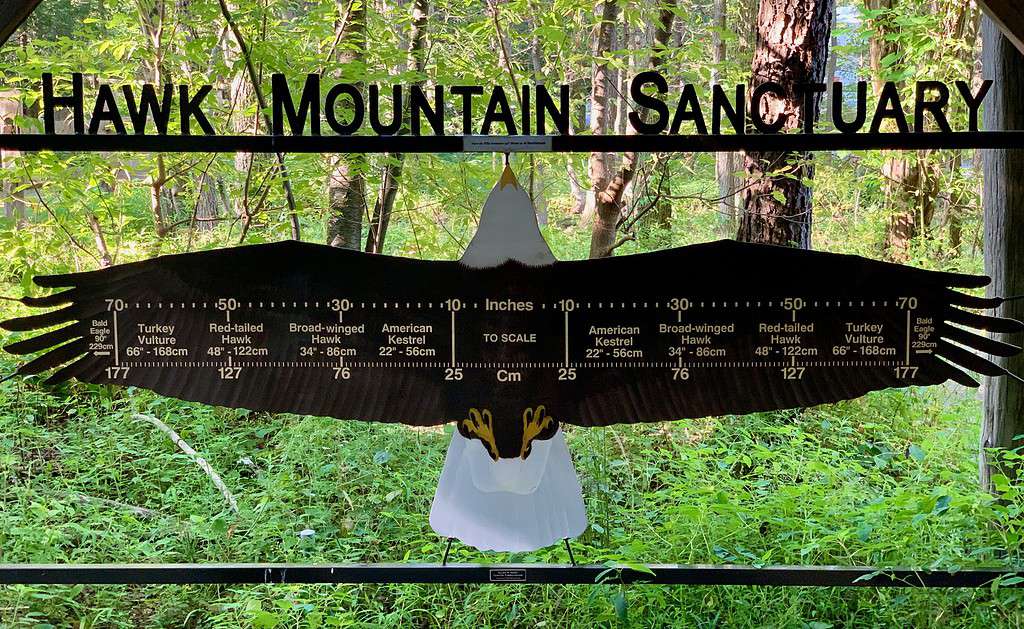
Different wing sizes of raptors as seen at Hawk Mountain Sanctuary PA
©Zeete / CC BY-SA 4.0 – License
Red-tailed hawk (Buteo jamaicensis)
The red-tailed hawk is a glider. They seldom flap their wings and can be seen soaring from great heights. Their wings are long and tapered, with five-finger feathers spread out on the tips when in flight. They have a wingspan of 41 – 58 inches.
Ferruginous hawk (Buteo regalis)
These birds pump their wings slowly and purposely like that of an eagle. It is the largest buteo hawk, even larger than the red-tailed hawk. Its wings are very straight, with five feather fingers at the wingtips. The edges on the underside of the feathers are white but closer to the body brown. They have a wingspan of 53 – 56 inches.
Red-shouldered hawk (Buteo lineatus)
These hawks have long, reddish, dark brown, and white striped wings. They have pale crescents at the tips of the wings. They have a wingspan of 36 – 40 inches and are medium-sized hawks. These birds are another commonly seen hawk in North America’s skies.
Broad-winged hawk (Buteo platypterus)
These birds have broad, pointed wings. The wings are either light or dark phase and can be brown underneath or white. Both have a thick black band that extends to the tips. They have a wingspan of 29 – 39 inches.
Sharp-shinned hawk (Accipiter striatus)
The sharp-shinned hawks look like a flying capital “T” due to their small heads and long tail feathers. They have a wingspan of 17 – 22 inches.
Cooper’s hawk (Accipiter cooperii)
These are lowercase “t” shaped birds that look very straight and cross-like when in flight. They have short rounded wings that are brown with a cream-colored underside. These birds have a wingspan of 24 – 35 inches.
Northern Goshawk (Accipiter gentilis)
These hawks have rounded tail feathers and wide wings. The dark upper and cream-colored underside of their wings gives them a beautiful, contrasting look. The goshawk has a wingspan of 38.5 – 41 inches.
Swainson’s hawk (Buteo swainsoni)
These impressive birds have long slender wings. This delicate and graceful-looking hawk glides effortlessly over open plains. Their wings appear more graceful than some others due to their small build and slender wings. Their wingspan is 46 – 54 inches.
Field Marks and Unique Features: Noting Specialized Physical Traits and Markings for Accurate Identification

Close-up of a red-shouldered hawk.
©Casey Ray Photography/Shutterstock.com
Red-tailed hawk (Buteo jamaicensis)
- The most common hawk seen throughout the United States.
- Frequently spotted on fences, poles, and tall objects next to interstates and highways.
- A dark brown vertical bar between mid-wing and wrist.
- They have a speckled brown and white band at the mid-point on their chest.
- They have long rust-red tail feathers.
Ferruginous hawk (Buteo regalis)
- White morph has a bright white underside, and dark morph has a chocolate brown underside.
- When in flight, their legs are pinned beneath their body in the shape of a “v.”
- This species is the largest in the buteo family of soaring hawks in North America.
- The only one with feathers down to its talons.
Red-shouldered hawk (Buteo lineatus)
- This species has dark brown or black and white flight feathers.
- They have black tails with several white bands.
- Red-shouldered hawks have cream-colored undersides with medium-brown streaks.
- The high, shrill “hawk cry” of these birds is loud and is the sound commonly associated with the species.
- They have long yellow legs.
Broad-winged hawk (Buteo platypterus)
- They have reddish rust-colored heads with thick black and white bands on their tail.
- These birds stick close to the forest’s edge and are seldom seen except during mating season.
- They have a pale-colored underwing.
- The broad-winged hawk is a short and broad bird with tapered, pointed wings.
Sharp-shinned hawk (Accipiter striatus)
- They have very long toes and talons.
- Females are a third bigger than males.
- They carry their prey to a low-lying branch and pluck the feathers off before eating birds.
Cooper’s Hawk (Accipiter cooperii)
- These birds stick to the woodlands and are timid.
- The black or dark grey crown looks like they are wearing a cap on their head along with a light-colored nape.
- They are the size of a crow with broad shoulders and narrow hips.
Northern Goshawk (Accipiter gentilis)
- They have large, wide, rounded wings and long tail feathers.
- Gohawks have long secondary flight feathers, which give their wings a buckled look when in flight.
- They are typically found in the north and west of the United States.
- These lovely raptors stick to the fringe of wooded areas when hunting.
- The only ones with their dark grey, black, and white barred look.
- White eyebrow line with black surrounding it.
Swainson’s hawk (Buteo swainsoni)
- They have a dark, short hooked beak.
- Swainson’s hawks have long wings with pointed tips.
- When soaring high in the sky, they often have their wings slightly raised above their bodies, similar to seabirds.
- They have a red “bib” under their heads that extends halfway down their chest.
The photo featured at the top of this post is © Jesus Giraldo Gutierrez/Shutterstock.com
Thank you for reading! Have some feedback for us? Contact the AZ Animals editorial team.






